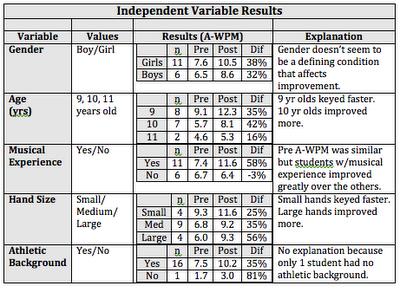What effect does a 4-week online computer keyboarding instructional tutorial have on 4th grade students?
Teaching keyboarding at the elementary level is the way it should be. Kids are using computers during their preschool ages and should be provided guidance early in their lives so as to develop good keyboarding habits. I must admit that I am not a fan of preschool keyboarding instruction. I think that it should begin about 3rd grade. Research states that 8 years old is a good age because students have developed the coordination and manual dexterity to keyboard efficiently.
I agree with the physical development statements, but more importantly they have a reason to communicate in a written format. It doesn’t make sense for kids to learn how to keyboard if they don’t have much to say.
Amy Lockhart and I had an opportunity to do some keyboarding research in her 4th grade classroom at Price Laboratory School at the University of Northern Iowa. We involved the students in 4-weeks of instruction. We spent 40 minutes a day in the computer lab learning how to keyboard. It was fun and productive.
We used the Almena Keyboarding Method. This is a unique form of instruction where instead of learning the homerow first, the Almena Method uses a series of mnemonic jingles for each finger’s keys. These jingles consist of three-word phrases that allow the students to learn the keys’ locations. The phrase, “Quiet Aunt Zelda”, was used to remember the left little finger keys; Q, A and Z. The phrase, “Over Longer Periods”, was used for the right ring finger keys; O, L and P.
The Almena Keyboarding Method was relatively successful. The 4th graders averaged an improvement of 2.6 Adjusted Words Per Minute (A-WPM). The A-WPM was calculated by subtracting the number of Errors Per Minute (EPM) from the WPM. While 2.6 doesn’t seem like much of an improvement, consider that they began at an average of 7.2 A-WPM. This means that they improved an average of 36% in keyboarding fluency. Not bad.
What was unique about our action research was that we also investigated how specific attributes affected students’ ability to keyboard. These characteristics were: Gender, Age, Hand Size, Music Experience, and Athletic Experience.
- Gender – Boy or girl.
- Age – Students’ ages ranged from 9 – 11 years old.
- Hand Size – Students’ hand sizes ranged from 5.0 to 6.75 inches in length from wrist to the tip of the middle finger. This variable was classified into three groups for analysis.
- Music Experience – Students were questioned about their musical experience. If they had taken lesson for playing a musical instrument, they were identified as having Musical Experience.
- Athletic Experience – Students were questioned about their athletic experience. If they had been involved in an organized athletic activity, they were identified as having Athletic Experience.
We had some interesting results. Here is an table displaying the overall results based upon Adjusted Words Per Minute:
What does this tell you? The small size of the sample does not allow us to generalize to a larger population, but it shows some trends that should lead to additional research.
- Musical experience seems to have an affect on success using keyboarding tutorials.
- Younger students tended to key faster then their older classmates.
- Students with smaller hands tended to key faster than their bigger-handed classmates.
We need to further analyze this data to investigate how multiple variables affect A-WPM. Do small-handed 9-year-olds key faster then bigger-handed 9-year-olds?
If this research catches your interest, you can download the whole .pdf file here:
What are your experiences in young students keyboarding?
What’s YOUR opinion?
Leave a comment and keep the discussion going.
Leave a comment and keep the discussion going.


Thank you, David Raven, Managing Director of AlmenaUSA Training, llc.
almenausa.net or find us on Amazon "Almena Method'
Thank you, David Raven, Managing Director of AlmenaUSA Training, llc.
almenausa.net or find us on Amazon "Almena Method'
Thank you, David Raven, Managing Director of AlmenaUSA Training, llc.
almenausa.net or find us on Amazon "Almena Method'
Thank you, David Raven, Managing Director of AlmenaUSA Training, llc.
almenausa.net or find us on Amazon "Almena Method'
This comment has been removed by a blog administrator.
This comment has been removed by a blog administrator.
This comment has been removed by a blog administrator.
This comment has been removed by a blog administrator.